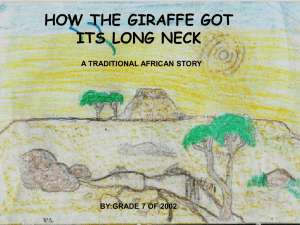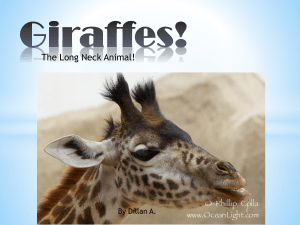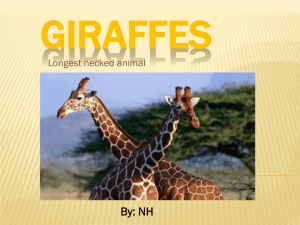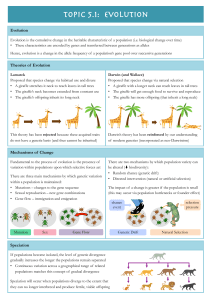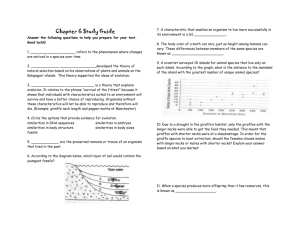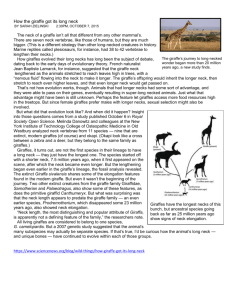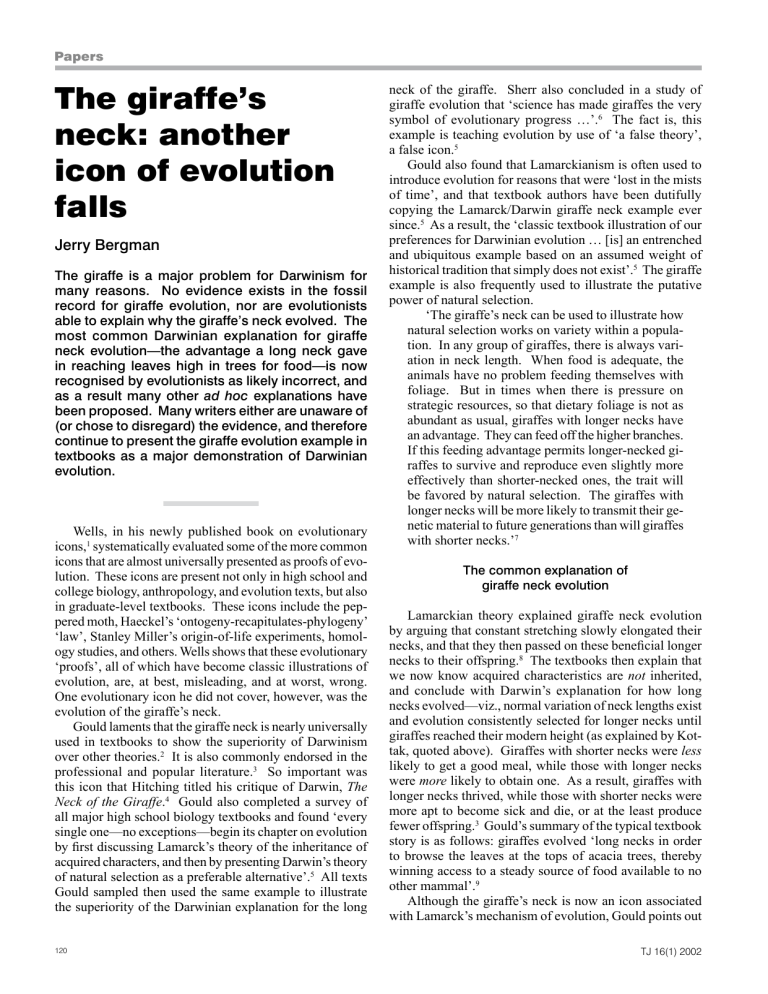
Papers The giraffe’s neck: another icon of evolution falls Jerry Bergman The giraffe is a major problem for Darwinism for many reasons. No evidence exists in the fossil record for giraffe evolution, nor are evolutionists able to explain why the giraffe’s neck evolved. The most common Darwinian explanation for giraffe neck evolution—the advantage a long neck gave in reaching leaves high in trees for food—is now recognised by evolutionists as likely incorrect, and as a result many other ad hoc explanations have been proposed. Many writers either are unaware of (or chose to disregard) the evidence, and therefore continue to present the giraffe evolution example in textbooks as a major demonstration of Darwinian evolution. Wells, in his newly published book on evolutionary icons,1 systematically evaluated some of the more common icons that are almost universally presented as proofs of evolution. These icons are present not only in high school and college biology, anthropology, and evolution texts, but also in graduate-level textbooks. These icons include the peppered moth, Haeckel’s ‘ontogeny-recapitulates-phylogeny’ ‘law’, Stanley Miller’s origin-of-life experi­ments, homology studies, and others. Wells shows that these evolutionary ‘proofs’, all of which have become classic illustrations of evolution, are, at best, misleading, and at worst, wrong. One evolutionary icon he did not cover, however, was the evolution of the giraffe’s neck. Gould laments that the giraffe neck is nearly universally used in textbooks to show the superiority of Darwinism over other theories.2 It is also commonly endorsed in the professional and popular literature.3 So important was this icon that Hitching titled his critique of Darwin, The Neck of the Giraffe.4 Gould also completed a survey of all major high school biology textbooks and found ‘every single one—no exceptions—begin its chapter on evolution by first discussing Lamarck’s theory of the inheritance of acquired characters, and then by presenting Darwin’s theory of natural selection as a preferable alternative’.5 All texts Gould sampled then used the same example to illustrate the superiority of the Darwinian explanation for the long 120 neck of the giraffe. Sherr also concluded in a study of giraffe evolution that ‘science has made giraffes the very symbol of evolutionary progress …’.6 The fact is, this example is teaching evolution by use of ‘a false theory’, a false icon.5 Gould also found that Lamarckianism is often used to introduce evolution for reasons that were ‘lost in the mists of time’, and that textbook authors have been dutifully copying the Lamarck/Darwin giraffe neck example ever since.5 As a result, the ‘classic textbook illustration of our preferences for Darwinian evolution … [is] an entrenched and ubiquitous example based on an assumed weight of historical tradition that simply does not exist’.5 The giraffe example is also frequently used to illustrate the putative power of natural selection. ‘The giraffe’s neck can be used to illustrate how natural selection works on variety within a population. In any group of giraffes, there is always variation in neck length. When food is adequate, the animals have no problem feeding themselves with foliage. But in times when there is pressure on strategic resources, so that dietary foliage is not as abundant as usual, giraffes with longer necks have an advantage. They can feed off the higher branches. If this feeding advantage permits longer-necked giraffes to survive and reproduce even slightly more effectively than shorter-necked ones, the trait will be favored by natural selection. The giraffes with longer necks will be more likely to transmit their genetic material to future generations than will giraffes with shorter necks.’7 The common explanation of giraffe neck evolution Lamarckian theory explained giraffe neck evolution by arguing that constant stretching slowly elongated their necks, and that they then passed on these beneficial longer necks to their offspring.8 The textbooks then explain that we now know acquired characteristics are not inherited, and conclude with Darwin’s explanation for how long necks evolved—viz., normal variation of neck lengths exist and evolution consistently selected for longer necks until giraffes reached their modern height (as explained by Kottak, quoted above). Giraffes with shorter necks were less likely to get a good meal, while those with longer necks were more likely to obtain one. As a result, giraffes with longer necks thrived, while those with shorter necks were more apt to become sick and die, or at the least produce fewer offspring.3 Gould’s summary of the typical textbook story is as follows: giraffes evolved ‘long necks in order to browse the leaves at the tops of acacia trees, thereby winning access to a steady source of food available to no other mammal’.9 Although the giraffe’s neck is now an icon associated with Lamarck’s mechanism of evolution, Gould points out TJ 16(1) 2002 Papers The giraffe’s neck: another icon of evolution falls — Bergman that Lamarck ‘offered no evidence for his interpretation and only introduced the case in a few lines of speculation’.5 Lamarck’s reference to giraffes consisted of only one paragraph, and was based on absolutely no data.10 Gould concludes that Lamarck’s major blunder in his giraffe discussion (Lamarck claimed wrongly that the animal’s forelegs evolved to become longer than its hind-legs), indicates that he ‘couldn’t have read the literature thoroughly’.11 The giraffe example is often used to explain not only Lamarckian evolution, but also to show that Lamarck’s explanation was wrong and that Darwin’s was correct. The typical textbook teaches that the giraffe’s neck did not get slightly longer after each generation because of stretching to reach the upper leaves of trees, but because taller giraffes had a selective advantage since they could reach the higher tree leaves.12 According to Gould, Darwin did not mention the giraffe’s neck as an evolutionary example in The Origin of Species until the 1872 edition.13 And Darwin addressed the issue of giraffe evolution in the sixth edition only in response to a critical review of his book by creationist St. George Mivart.14 In this work it is clear that Darwin never regarded the giraffe’s long neck as evidence of the superiority of natural selection (as biology and many other texts that discuss evolution imply almost without exception). The textbooks usually claim that the old Lamarckian theory was refuted and replaced by Darwin’s new theory, when, in fact, Darwin held to many ideas that were in vogue in his day which we today know are wrong. The term ‘Neo-Darwinism’ developed after Darwin died and is used to describe Darwin’s theory with Lamarckianism removed. The textbooks rarely, if ever, mention this, thus leaving a false impression about Darwin and even implying at times that he was some sort of super-genius who figured out all the right answers (in contrast to his predecessors, who often were wrong). Why the giraffe example is used to support Darwinism A major reason that the giraffe example is used to support evolution is because it is an easily explainable, memorable and eloquent example that can effectively illustrate Darwinism via artwork or photographs.13 The explanation required is simple and easy to grasp: longer necks can reach higher levels of acacia trees and as a result those with longer necks were more apt to survive. Virtually all texts picture giraffes eating from acacia trees, incorrectly implying that this is the main giraffe diet. In Simmons and Scheeper’s words, ‘so appealing is this hypothesis that students of giraffe behavior and evolutionary biologists alike accept it implicitly’.15 For most young people, the giraffe is one of the most intriguing and exotic of all animals. It is so unusual, and in such contrast to other animals, that students typically are more fascinated with it than many of the other equally TJ 16(1) 2002 amazing animals. In fact, the word giraffe is derived from the Arabic zerafa, a phonetic variant of zarafa, meaning ‘charming’ or ‘lovely one’.16 As one author stated, viewing a giraffe is one of humankind’s greatest visual experiences. Unfortunately, their present-day range is limited to the dry savannas and semi-desert areas of Africa south of the Sahara.17 Major problem with the giraffe story This time-worn evolutionary example, however, suffers from major problems. In fact, scientists ‘have no proof that the long neck evolved by natural selection for eating leaves at the tops of acacia trees. We only prefer this explanation because it matches current orthodoxy’.5 Although the tall acacia tree leaves are the preferred food for adult giraffes during the wet season, giraffes will browse on many other trees and bush types. Hitching notes that, on average, female giraffes are up to a metre shorter than males—and they survive quite well. He also claims that there is plentiful foliage at lower-levels, and that giraffes often eat bushes and even low-growing land vegetation.4 Actually, giraffes commonly munch on long grass and low bushes and many kinds of ground-growing plants.18 Much is said by evolutionists about the giraffe’s neck providing it with an advantage of being able to munch on tree leaves (an unexploited niche), but the claim that giraffes exploited an empty niche is an incorrect, ad-hoc explanation. Gould asks if such a habit is so beneficial, why haven’t many other animals (such as antelopes) also evolved the same ability?7 It could be argued just as easily that giraffes with shorter necks were much more apt to survive because most foliage in the part of Africa where they live is near the ground, and for this reason it would be a decided survival advantage to be closer to the more plentiful ground vegetation compared to the comparatively rarer acacia tree leaves. Thus, being able to reach the heights of trees is not necessarily a survival factor.15 It is for this reason that Hitching concludes the Darwinism explanation to be mere ‘post-hoc speculation’.21 Recent research that attempted to verify the Darwinian explanation has found that at times when the feeding competition should be the most intense (e.g. during the dry season), giraffes generally do not feed on tall trees, but instead eat from low shrubs.22 Until their neck has grown long enough to reach the trees (3 to 4 years of age), all young giraffes feed on long grass and bushes. Females spend over half their time feeding with necks horizontal, indicating that their neck’s length may usually be a handicap in feeding. In the African Serengeti, all giraffes spend ‘almost all of the dry-season feeding from low growing bushes, while only in the wet season do they turn to Acacia tortilis trees, when new leaves are both protein rich and plentiful’.23 Giraffe’s diets are extremely varied. ‘The giraffe lives on what it can browse, plucking leaves with its 17-inch tongue or pulling a branch 121 Papers The giraffe’s neck: another icon of evolution falls — Bergman into its mouth and pulling off leaves with a twist of its head. It prefers the leaves of the acacia trees … . But there are more than 100 plant species on the giraffe’s menu, including flowers, vines, herbs, along with an occasional weaver-bird nest. If there are chicks in the nest, the giraffe eats them too, gaining some extra minerals from their bones. Giraffes also get minerals by gnawing on the bones of animals killed and left by hyenas and other predators.’24 Simmons and Scheepers found that only in one location did male giraffes spend most of their time feeding in higher trees. The finding that both sexes not only feed most often, but also feed faster, with their necks bent downward, indicates, in contrast to the Darwinian icon, that ‘long necks did not evolve specifically for feeding at higher levels’. The authors concluded that ‘little critical support for the Darwinian feeding competition idea’ exists.25 Although evolutionist Gould notes that giraffes do tend to munch on the leaves near the tree’s top, he admits that the giraffe neck evolution example rests upon no data at all for the superiority of the Darwinian explanation and, furthermore, we do not know ‘how or why’ giraffes’ necks elongated.5 Another major problem with the standard textbook story is that, although Darwin believed the inheritance of acquired characteristics was less important than natural selection, he did accept Lamarckianism. In other words, Darwin accepted the idea that evolution could occur by use and disuse of body parts.18 The source of the ubiquitous textbook icon of giraffe neck evolution is unknown. Gould traced it back to Henry Fairfield Osborn’s book, The Origin and Evolution of Life.19 Osborn’s inaccurate account would have us believe that Lamarck attributed the neck lengthening to the inheritance of bodily modifications as a result of stretching its neck for food, while Darwin attributed it to the constant ‘selection of individuals and races which were born with the longest necks’.20 Osborn concluded that ‘Darwin was probably right’. Lamarck’s conclusion that the giraffe stretching its neck to reach tree leaves caused it to evolve a longer neck is also disputed by the example of the okapi (an animal that looks very much like the giraffe, except for the fact that its neck is only slightly longer than a horse’s). The okapi also stretches its neck in the same way as the giraffe to reach food, yet its neck has not changed from those found anywhere in the fossil record. Whitfield concludes, ‘this demonstrates that evolution is not driven by simple patterns of use and non-use’.26 The okapi example also argues against the mutation/natural selection scenario. The okapi’s diet is limited to the very lowest levels of trees, and any mutation that would lengthen its neck (to be like the giraffe), would also seem to facilitate its increased likelihood of survival because it could rely on both the lower and higher trees for food. Other problems with the 122 Darwinist textbook story Other evolutionists believe that it is just as likely that giraffe necks evolved, not to help them obtain food, but for quite different reasons. One common speculation is the long neck evolved to aid in mating. Gould concludes that the chief adaptive reason for evolving long necks could well be sexual success ‘with a much-vaunted browsing of leaves as a distinctly secondary consequence’.27 Sherr claims that the longer the neck, the better males can perform their ritual dominant battles called ‘necking’.28 The theory that the extraordinary neck length arose from its use in intersexual competition assumes that the ‘necking’ behavior evolved first, then the neck length evolved as a result of selection. Aside from the fact that no evidence exists for this ‘necking’ theory, another problem is that a short-necked giraffe would not be able to use its neck as a club, thus ‘necking’ would be totally ineffective until giraffes had sufficiently long necks. How could necking behaviour evolve until they had a long enough neck to involve themselves in necking behavior. They may have used butting behavior (as do male deer) until their necks evolved. A problem with this theory is that the longer-necked giraffe was at a distinct disadvantage for butting behavior (which requires a short, thick neck), and would be ‘selected against’ in nature. Furthermore, the necking hypothesis would not explain the giraffe’s very long legs. Mating rituals are relatively varied and flexible, and evolving a longer neck is fraught with anatomical and biological problems that must be overcome (some of which are discussed below). The principle in science called Ockham’s Razor argues that it would be far easier for a more functional mating ritual to evolve necks like almost all other animals use rather than for a 3-metre neck to evolve. Some evolutionists suggest that giraffes’ long necks evolved as a lookout tower to spot potential predators. Their long neck, coupled with their excellent vision, enables them to spot a lion miles away. The theory of neck evolution to help the giraffe become aware of enemies is plausible, but the giraffe has virtually no enemies—the lion is about the only wild animal that will attack one, and then usually only when it is desperate. Hitching notes that a lion is little match for a 900 kg giraffe—the giraffe hoof can kill a lion with a single blow. Lions are able to kill giraffe cubs, and adult giraffes are vulnerable primarily when they have their legs spread while eating low ground cover or drinking. The giraffe’s best defense actually is not their neck, as some have assumed, but their long legs and heavy hooves, which can be deadly to enemies. They defend themselves primarily by kicking. This may be said to explain why they supposedly evolved long legs, but not why they evolved a long neck. A popular Gary Larson cartoon pictured giraffe evolution as progressing from long legs and a short neck to short legs and a long neck. This humorous parody has actually been proposed by some researchers, i.e. that the legs evolved first to allow running from carnivores, then TJ 16(1) 2002 The giraffe’s neck: another icon of evolution falls — Bergman Papers The long necks could have been selected for all these reasons—or none of them. Because one could argue equally well that giraffes evolved their long neck for mating, for defense, thermoregulation, to facilitate their fast forward travel (up to 50 km/h), or for one of many other different reasons, it is a poor icon of Darwinism. One could list a hierarchy of what is most critically important (perhaps this may be why the food scenario was preferred); but the set of giraffe traits as a unit seems inseparable, supporting Creation. Although other hypotheses have been proposed to explain the giraffe’s unusual morphology by natural selection (which space limitations prohibit discussing here), it is sufficient to say that all are inaccurate and fraught with problems. As Gould concludes, ‘the giraffe’s neck cannot provide a proof for any adaptive scenario, Darwinian or otherwise’ (emphasis added).29 Truth be told, the giraffe’s neck is far more useful as an example of the many problems with Darwinism. Is there fossil evidence for giraffe non-evolution? Much controversy exists about giraffe evolution, partly because no empirical evidence of evolution exists and therefore scientists are free to speculate without any evidentiary constraints. As a result, they have tried to link giraffes to a variety of often very dissimilar animals.30 About a Giraffes defend themselves primarily by kicking. A well-placed hoof can kill a lion with dozen races of giraffe (Giraffa camelopara single blow. The adult giraffes are vulnerable primarily when they have their legs dalis) are recognized. Giraffes fossils are spread while eating low ground cover or drinking. The ability to kick is nullified by the plentiful and their bones do not vary much, awkard-looking posture they assume. if at all, in shape or size. The extant fossil evidence leads to the conclusion that giraffes the neck grew so that the giraffe could stretch down to eat have been unchanged for about ‘two million years’, under long grass and drink water. This scenario also has problems. uniformitarian dating methods.31 Furthermore, the fossil Long legs do not necessarily give the giraffe an advantage evidence that does exist ‘provides no insight into how the to outrun predators. In fact, many of the fastest animals long-necked modern species arose’.32 alive have legs far shorter than a modern giraffe’s. The seven giraffe cervical vertebrae and the leg bones Giraffes’ long necks are critical in allowing them to are about the same in number, and very similar to, those rise from a lying position (they use their neck to shift their of virtually all other mammals, but are comparatively weight, allowing them to stand on their long legs) and esgreatly elongated in shape.33 If giraffe neck and leg elongapecially in running (which involves a snake-like, slithery tion occurred, this should be plainly obvious in the fossil movement that propels their entire body forward in a beautibones—yet none that support neck evolution have ever been ful, rhythmic flow). The long, thin giraffe neck provides a discovered. Savage and Long concluded that the origin of great deal of surface area, which allows effective cooling all three of the main lineages of the pecorans (giraffes, deer, (for this reason, giraffes—in contrast to many other large and cattle) ‘remains obscure’ because of the major void in mammals that live in warm temperate areas—can remain fossil evidence.34 It is believed that at the beginning of the in the hot sun for long periods of time). Pleistocene, giraffes inhabited large parts of Eurasia and TJ 16(1) 2002 123 Papers Africa; thus, there should be abundant fossil remains. Some evolutionists claim the lack of evidence for giraffe evolution is due to a lack of effort in searching for giraffe fossil evidence. Creationists, in contrast, claim that paleontologists, after unearthing millions of fossil bones, have not located any evidence for transitional stages in giraffe neck elongation because these stages do not exist. One guess of Darwinists is that the ancestor of giraffes was an elk-sized creature called Palaeotragus found near Athens.6,35 This conclusion is based solely on the fact that the animal ‘closest’ to the giraffe in the fossil record is the Palaeotragus. The Palaeotragus was believed to be an early giraffid, which many paleon­tologists say left two groups of descendants in the Pleistocene.36 These include the sivatheres, which were heavy-bodied animals (as big as an elephant) that once roamed not only Africa, but also evidently India as well. The sivatheres had short necks and elaborate horns known as ossicones (palmate, or flat antler-like structures very different from those on modern giraffes). Many sivatheres bones were only half as long as those of modern giraffe, and there were many other differences between the two taxons as well.31 The second 124 The giraffe’s neck: another icon of evolution falls — Bergman branch of the sivathere group is hypothesized to be the family Giraffidae. The orthodox view of giraffe evolution is that the giraffe emerged as a separate line during the Miocene. Fossil evidence for this scenario, though, is nonexistent, and much controversy exists about all of the hypothetical scenarios of giraffe evolution.37 It is assumed that the primitive giraffe was a fast, agile animal similar to the modern forest-dwelling okapi, which is a rather large artiodactyl about 1.6 m at the shoulder.38 The only extant giraffid other than the giraffe, is the rare okapi. It is totally restricted to central Africa where it lives deep in the rain forest. It has a long neck and forelegs and many deerlike traits, and is assumed to be very similar to the extinct Palaeotragus.39 Its existence was only confirmed in 1901, at which time the claim was made that it is the ‘last and only large mammal to escape the notice of science until the twentieth century’ (a claim disproven many times since then). Although Palaeotragus was felt to be the first giraffe, fossil remains of the Palaeotragus indicate that it actually was a type of okapi. So there is fossil evidence of animals virtually identical to modern okapi, and it is assumed that giraffes evolved from ancient okapi—in spite of a complete lack of fossil evidence for this theory. The evidence better fits the theory that the Palaeotragus was actually an okapi that has existed unchanged in the fossil record. Giraffes are classified as artiodactyls (the order Artiodactyla are ungulates that have an even number of toes, either two or four on each foot, with the axis of the foot, located between the third and fourth toes). Artiodactyls include deer, antelopes, the antelope-like pronghorns, cattle (bovidae), sheep and goats; also the okapi which is classified with the giraffe, in the giraffid family.40 Other animals suggested as precursors of the giraffe include the Samotherium, an animal that looked somewhat like a deer, but larger and with a slightly longer neck. It is also theorized that giraffes may have evolved from the cervoids, deer-like animals with side toes that are part of the superfamily Cervoidea. It is hypothesized that since giraffes lack side toes, these must have been lost during evolution. The giraffe is the only living member of its genus (Giraffa), and there is no evidence that any animal similar to it ever lived in history. Likewise, there is no fossil evidence for evolution of the okapi, which is often called a living fossil because it has ‘survived basically unchanged for fifteen-million years in the isolated cover of its primitive environment’.41 A major problem is that, in spite of an abunTJ 16(1) 2002 Papers The giraffe’s neck: another icon of evolution falls — Bergman dance of fossil remains, the record does not provide a basis for any of the many existing evolutionary specu­lations. Does molecular biology support giraffe evolution? The evidence from genetic studies has not supported the Darwinian position. In a study of 27 species, including bovidae and giraffes, the results were ‘far from constant’.42 A study of chromosomes found the pronghorn family was the most similar karyotypically, and that the giraffe differed from the other artiodactyls in many significant ways, such as ‘having a preponderance of biarmed autosomes’.43 The giraffe supports Creation A problem for evolution is that the giraffe’s entire body—both its anatomy and physiology—is tightly intertwined as a single functional unit.44,45 The giraffe is actually an excellent icon for intelligent design because its extreme complexity requires all of the pieces to be in place before its neck structure is functional. As Darwin said, it was a beautiful animal with ‘an admirably coordinated structure’ in its neck. The common explanation of the giraffe’s long neck is not that it was produced by Lamarckian evolution, but instead that it ‘was a mistake or mutation that worked’.46 Actually, producing a longer neck would require hundreds or thousands of simultaneous (or almost simultaneous) mutations, a set of events that, for all practical purposes, has a probability of zero. The giraffe’s anatomy poses a major problem to evolution. In Gould’s words, ‘… the long neck must be associated with modifications in nearly every part of the body—long legs to accentuate the effect, and a variety of supporting structures (bones, muscles, and ligaments) to hold up the neck’.47 Giraffes need not only long necks to reach tall trees, but also long legs and even long faces and tongues to reach the high growing acacia leaves. How natural selection simultaneously altered neck, legs, tongue, prehensile lips, knee joints, muscles, and blood flow system (needed to pump blood up from the heart to the giraffe’s distant brain) is a major problem for Darwinists. Giraffes, the tallest animals in the world, may be up to 5 m to the tip of their heads. To eat on the ground, the giraffe must move its head to a point about 2 m below its heart and, when upright, to a point about 3.3 m above it. Grazing and drinking normally48 would cause a sudden rush of blood to and from a giraffe’s brain—a severe problem that has been solved by a complex and unique blood valve system. Its strong heart must beat 150 times per minute. A mass of spongy tissue below the brain helps regulate the blood flow to the brain so that rapid changes can be blunted.45,49 Gould has noted that the suggestion that all of the relevant parts changed together ‘in one fell swoop … would invalidate natural selection as a creative force because the desired adaptation would then arise all at once as a fortuiTJ 16(1) 2002 tous consequence of internally generated variation’.50 The solution Darwin proposed was that these features need not have evolved in lock step. That is to say, if the neck elongates a few inches at a time, then the panoply of necessary supporting structures also correspondingly evolves in step, and may give an animal with the slightly longer neck a slight advantage if, for example, it already had a larger heart. This process, in theory, would allow for multi-step evolution. Gould calls this ‘conjectural biology’, but actually it is speculation based upon the unsupported assumption that the neck slowly evolved. The problem with this assumption is that not only quantitative changes, but also qualitative changes, are required to produce a different neck and blood vessel design—and the assumption of qualitative changes produces problems. Such speculations are indulged on the basis of the assumption that neck and leg evolution changed a deer-like animal into a giraffe—an assumption that has no basis in fact. Some newer attempts to deal with this question are worse than the older incorrect explanations. For example, in answer to the question ‘How did the giraffe acquire its long neck?’ Kuttner51 stated ‘Not as you may think, by stretching its neck to reach foliage in tall trees. It is because of the giraffes’ mating with antetypes that had longer necks, that this species outlived those with shorter necks. This is an example of natural-selection theory as propounded’ by Darwin. This raises the question ‘Where did the hypothetical antetypes come from and why did they evolve?’ Summary The giraffe has been used by evolutionists as their classic example of extreme morphological adaptation to the environment. It is often the primary example of natural selection in textbooks. Most biologists since Darwin have explained the length of the giraffe’s neck (in an evolutionary context) as a result of competition with other mammalian browsers.52 In fact, this example of evolution is not based on evidence, but rather on armchair reasoning that turns out to be incorrect. The giraffe is only one of many icons of evolution that sound persuasive, and that have been used extensively to propagate evolution, but are wrong. In conclusion, we agree with Gould that the standard story of giraffe evolution ‘in fact, is both fatuous and unsupported’, and that ‘in the realm of giraffes, current use of maximal mammalian height for browsing acacia leaves does not prove that the neck evolved for such a function’. Gould believes that several alternative scenarios exist to explain why giraffes have long necks.53 In fact, we have no scientific evidence supporting any one of his naturalistic explanations, nor do we we have evidence to prefer any plausible naturalistic version over another. All explanations are an attempt to try to explain what exists by developing what amounts to what Gould calls ‘just so stories’. As Hitching notes, ‘the evolution of the giraffe, the tallest living animal, is often taken as classic evidence that 125 Papers The giraffe’s neck: another icon of evolution falls — Bergman Darwin was right and Lamarck wrong’,54 but a study of giraffes provides no ‘evidence whatsoever for how their undeniably useful necks evolved’.55 As a Darwinist, he is concerned about using the giraffe’s neck example as support for evolution because, as he states, ‘if we continue to illustrate our conviction [of Darwinian evolution] with an indefensible, unsupported, entirely speculative, and basically rather silly story … ’, then evolutionists are in trouble.54 It is clear from biology, and especially molecular biology, that evolution is in trouble.1 Gould’s major concern about this case is ‘if we choose a weak and foolish speculation as a primary textbook illustration (falsely assuming that the tale possesses a weight of history and a sanction in evidence), then we are in for trouble—as critics properly nail the particular weakness, and then assume that the whole theory must be in danger if supporters choose such a fatuous case as a primary illustration.’56 The critics now have nailed not only this major weakness in Darwinism, but its many other weaknesses as well. Acknowledgments I wish to thank Wayne Frair, Bert Thompson and John Woodmorappe for their comments on an earlier draft of this paper. Glossary Antetypes — something that foreshadows a later type, or in biology an animal that is hypothesized to come before a later animal type. An evolutionary ancestor. Autosomes — all chromosomes other than the sex chromosomes; In humans autosomes include all the chromosomes except the X and Y. Homologous — similar structures in different animals believed by Darwinists to have the same evolutionary origin from a common ancestor, such as the wings of a bat, the arms of a human and the flippers of a dolphin. Karyotype — a complete set of chromosomes of a cell, individual, or species. Lamarckianism — a now discredited theory of evolution that postulated characteristics acquired during one’s lifetime, such as necks made longer by a lifetime of stretching, are passed on to one’s offspring and produce permanent genetic changes in the populations. The giraffe was one of the most common illustrations used to explain this concept in textbooks. Miocene period — a geological epoch of the Tertiary period that Darwinists believe occurred after the Oligocene and before the Pliocene about 10 to 25 million years ago according to the evolutionary timescale. This period is characterized by grazing animals. 126 Morphology — the physical shape of a plant or animal, or animal part or structure. Neo-Darwinism — the revised, newer view of evolution, primarily the addition of mutation theory to classical evolution by natural selection. The term was coined by George Romanes in 1905 to describe Darwin’s theory with Lamarckianism removed. Ontogeny — the path of development an organism takes from a fertilized egg to birth. Ossicones — small lumps of cartilage under the skin on the head of the young giraffe that ossify to form horns as the animal matures. Palaeotragus — an extinct okapi-like animal about the size of an elk known only by fossils. Palmate — an animal having webbed toes. The distal portion is broad and lobed like a hand with the fingers spread. Phylogeny — the theoretical evolutionary history of a group of organisms. Pleistocene period/era — the time from the end of the Pliocene to the beginning of the Holocene estimated to be from 20,000 to 2 million years ago. Often called the Ice Age because this was characterized by a series of glacials. Pronghorn — an antelope-like ruminant animal. The term means ‘pointed horn’. A prong is a pointed projection such as found on some animal horns. Savannas — a large flat land area characterized by many coarse grasses and sparse, scattered tree growth. Taxon — any grouping within the classification of organisms such as species, genus, order, etc. Thermoregulation — biological regulation of body heat. The means and process used to maintain the animals proper body temperature. Ungulates — herbivorous mammals that have hoofed feet. Ungulates are grouped into two orders, the Artiodactyla and Perissodactyla. References 1. Wells, J., Icons of Evolution, Regnery, Washington, DC, 2001. See also, Truman, R., What biology textbooks never told you about evolution: a review of Wells, J., Icons of Evolution: Science or Myth? Why much of what we teach about evolution is wrong, TJ 15(2):17­–24, 2001. 2. Gould, S.J., Bully for Brontosaurus, Norton, New York, 1991. 3. Vargas, J.M., Stephens, C.R., Waelbroeck, H. and Zertuche, F., Symmetry breaking and adaption: evidence from a ‘Toy Model’ of a virus, BioSystems 51:1–14, 1999. 4. Hitching, F., The Neck of the Giraffe: Where Darwin Went Wrong, Ticknor and Fields, New Haven, 1982. 5. Gould, S.J., Leonardo’s Mountain of Clams and the Diet of Worms: Essays on Natural History, Harmony Books, New York, p. 302, 1998. 6. Sherr, L., Tall Blondes, a Book about Giraffes, Andrews McMeel, Kansas City, p. 40, 1997. 7. Kottak, C.P., Anthropology; Exploration of Human Diversity, McGrawHill, New York, p. 166, 2000. 8. Lamarck, J.B. de., Zoological Philosophy, translated by Elliot, H., Macmillan, London, p. 122, 1914. TJ 16(1) 2002 Papers The giraffe’s neck: another icon of evolution falls — Bergman 9. Gould, Ref. 5, p. 302–303. 46. Sherr, Ref. 6, p. 40. 10. Sherr, Ref. 6, p. 41. 47. Gould, Ref. 5, p. 309. 11. Gould, Ref. 5, p. 306. 48. When water is available, giraffes drink regularly from ponds and streams, but during a drought they can survive very well without water for several weeks at a time. 12. Hoagland, M., Dodson B. and Hauck, J., Exploring the Way Life Works: The Science of Biology, Jones and Bartlett, Sudbury, MA, 2001. 13. Gould, Ref. 5, p. 312. 14. Spinage, C.A., The Book of the Giraffe, Collins, London, 1968. 15. Simmons, R.E. and Scheepers, L., Winning by a neck: sexual selection in the evolution of giraffes, The American Naturalist 148(5):771–786, 1996; p. 771. 16. Allin, M., Zarafa: A Giraffe’s True Story, From Deep in Africa to the Heart of Paris, Walker and Company, New York, p. 5, 1998. 17. Burton, M. and Burton, R., Giraffe, The International Wildlife Encyclopedia, Vol. 7, Marshall Cavendish, New York, pp. 884–889, 1969; p. 885. 18. Gould, Ref. 5, p. 312. 19. Gould, Ref. 5, p. 314. 20. Osborn, H.F., The Origin and Evolution of Life, Scribner’s, New York, pp. 249–250, 1917. 21. Hitching, Ref. 4, p. 179. 22. Simmons and Scheepers, Ref. 15, p. 771. 23. Simmons and Scheepers, Ref. 15, p. 775. 24. Allen, T., Animals of Africa, Levin, Washington, p. 86, 1997. 25. Simmons and Scheepers, Ref. 15, p. 771. 26. Whitfield, P., The Natural History of Evolution, Doubleday, New York, p. 13, 1993. 49. Hofland, L., Giraffes; animals that stand out in a crowd, Creation 8(4):11–13, 1996. 50. Gould, Ref. 5, p. 309–310. 51. Kuttner, P., Science’s Trickiest Questions, Barnes & Noble, New York, pp. 66, 217, 1998. 52. Simmons and Scheepers, Ref. 15, p. 5. 53. Gould, Ref. 5, p. 318. 54. Hitching, Ref. 4, p. 178. 55. Gould, Ref. 5, p. 315. 56. Gould, Ref. 5, p. 314. Jerry Bergman is working on his ninth college degree. His major areas of study for his past college work was in biology, chemistry, psychology, and evaluation and research. He was graduated from Wayne State University in Detroit, Medical College of Ohio in Toledo, and Bowling Green State University among others. A prolific writer, Dr Bergman teaches biology, chemistry and biochemistry at Northwest State in Archbold, Ohio. 27. Gould, Ref. 5, pp. 317–318. 28. Sherr, Ref. 6, p. 42. 29. Gould, Ref. 5, p. 317. 30. Dagg, A.I. and Foster, J.B., The Giraffe: Its Biology, Behavior and Ecology, Van Nostrand Reinhold, New York, 1976. 31. Sherr, Ref. 6, p. 42. 32. Gould, Ref. 5, p. 315. 33. Gould, Ref. 5, p. 309. 34. Savage, R.G. and Long, M.R., Mammal Evolution, Facts on File, New York, p. 228, 1986. 35. Benton, M.J., The Phylogeny and Classification of the Tetrapods, Vol. 2: Mammals, Clarendon Press, Oxford, 1988. 36. Stahl, B.J., Vertebrate History: Problems in Evolution, Dover, New York, p. 523, 1985. 37. Janis, C.M. and Scott, K.M., The phylogeny of the ruminantia (Artiodactyla, Mammalia); in: Benton, Ref. 35, Chapter 10. 38. Colbert, E., Evolution of the Vertebrates, Wiley, New York, p. 395, 1961. 39. Stahl, Ref. 36, p. 523. 40. Colbert, Ref. 38, p. 372. 41. Sherr, Ref. 6, p. 42. 42. Georgiadis, N.J., Kat, P.W. and Oketch, H., Allozyme divergence within the bovidae, Evolution 44(8):2135–2149, 1991. 43. Gallagher, D.S. Jr, Derr, J.N. and Womack, J.E., Chromosome conservation among the advanced pecorans and determination of the primitive bovid Karyotype, J. Heredity 85(3):204–210, 1994. 44. Davis, P. and Kenyon, D., Of Pandas and People; The Central Question of Biological Origins, Haughton, Dallas, 1993. 45. Brantley, G., A Living Skyscraper, Discovery 5:26, April 1994. TJ 16(1) 2002 127


